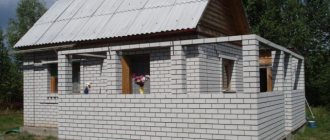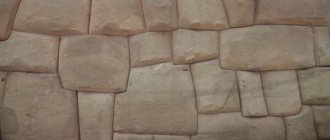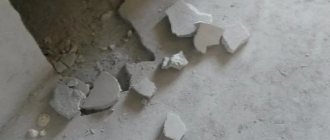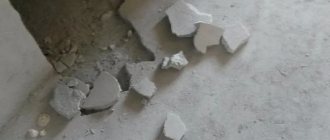There are no unnecessary things. There are those that have not yet found use. We want to offer you ideas for using concrete blocks, which are often left after construction and lie in the far corner of the site, forgotten and abandoned by everyone.
What can be made from concrete blocks? You can build a house from them. What else? Well, for example, build some kind of outbuilding. Can you think of anything else? It turns out that you can make a lot of interesting and useful things from unnecessary concrete blocks. Our selection today is about them.
Concrete blocks can be solid or hollow. For non-intended use, both one type and the other are suitable.
Raised beds made of concrete blocks
You can make high beds from concrete blocks, which is very important on the eve of the next summer season. You adjust their height yourself by laying out the required number of rows of blocks in height. It is easier to cultivate such beds than standard ones, because you do not need to bend low. They have many other advantages:
- Pros and cons of raised beds
Spring is coming, which means it’s time for new experiments. For example, instead of the usual ones, you can make high beds in the garden. But is it worth it? Let’s discuss it together.
A fence made of concrete blocks will not only give the garden bed a finished and neat look, but will also protect the soil from erosion. In addition, you can protect your plantings from moles and weeds. This needs to be taken care of at the initial stage of arranging a high bed:
- Level the ground.
- Lay down a metal mesh that will prevent moles and other earth-moving pests from entering the garden bed.
- Lay a layer of agrotextile on top of the mesh. Its purpose is to prevent weeds from germinating.
- Lay down a row of concrete blocks. If your blocks are hollow, pour soil into the recesses, which, firstly, will give the structure additional stability, and secondly, increase the area for planting crops.
- Apply a layer of fertile soil and plant/sow vegetables.
A fence made of concrete blocks has one more advantage: in the spring, before the weather gets warmer, you can install arcs for covering material in the cells of the blocks - you will get a small greenhouse.
Later, plant flowers in the soil that is filled into these voids. They will not only add color to your garden, but also protect vegetables from many pests.
- Decorative vegetable garden, or how to grow flowers and vegetables in the same bed
We'll tell you how to combine flowers and vegetables in one garden bed.
Exterior decoration of the house
For exterior decoration, you can choose inexpensive polystyrene foam panels to resemble bricks.
The appearance of the walls is not very presentable, plus they absorb moisture well. Therefore, exterior decoration performs a protective and aesthetic function. When choosing a material and style of cladding, you need to focus on factors such as the design of nearby buildings, the design of the site and the climate. The likelihood of vandalism affecting the coating should also be taken into account.
Options:
- siding;
- sandwich panels;
- decorative plaster;
- composite slabs;
- a natural stone;
- ceramic tile;
- plastic panels;
- silicone paint;
- imitation timber.
Any decision will be correct if it is technologically sound and its appearance evokes positive emotions among others.
Vertical flower beds
Concrete blocks left over from construction can also be used to create flower beds.
Concrete blocks placed randomly can easily be transformed into a vertical bed for succulents. With such a flowerbed you can cover an unsightly fence or use it as a wall that will protect you from the views of nosy neighbors. The blocks can be painted if desired to make the flower garden more cheerful.
Vertical flower beds can be not only straight, but also angular. When creating such a flower bed, align the blocks using a level so that you get an angle of 90°. By the way, you can plant not only succulents in the recesses of the blocks, but also other low flowers that are used in container gardens: primrose, petunia, lobelia, Turkish carnation, geranium, alyssum, nasturtium, etc.
- Container garden - which plants to choose and how to arrange them beautifully
We share with you little secrets of creating a beautiful, fragrant, stylish container garden.
A very interesting solution is to paint the blocks black. Against its background, flowers look brighter and more interesting.
Plants from small pots don’t even need to be planted in recesses, but placed there along with the containers.
What colors is it suitable for?
The choice of varieties of ornamental grasses and flowering plants largely depends on the characteristics of the future structure, primarily on its shape and height. It is believed that tall plants with large bright flowers are best suited for the top row of blocks. If a flower bed made of blocks is planned as a fence, then the top row is best planted with low-growing but bright flowers, ornamental grass and even garden crops.
For a single-row design of a flower bed fence made of foam blocks, it is best to use bushy plants with powerful leaves and thick stems. Typically, such a flower garden not only decorates and complements the landscape, it is also a full-fledged hedge, for example, around a gazebo or a place for evening tea.
Experts recommend planting on blocks:
- Astilbe, this classic plant for any flower beds and flower beds, takes root well and can withstand even severe shading of the surface;
- Gelenim will provide a good filling of the flower bed with green mass and bright flowers. Loves warmth, afraid of shadows;
- Geranium and catnip, two completely different plants to care for, are considered classic options for filling a flower bed.
With timely care and watering, poppy and sedum can be planted on the blocks, and anemones and yarrow are well suited as a green background for a flower garden. Plants with a stem height of 250-500 mm are planted at a rate of 7-10 per square of soil; the density of flowers growing up to 200 mm and bulbous plants, without height restrictions, are sown at double the rate. It is clear that one has to take into account the shading of the blocks and the presence of vertical walls adjacent to the upper edge of the flowerbed.
garden bench
Do you want to make your own garden bench? It's very simple! Take concrete blocks with through holes and a wooden beam. First, arrange the blocks in the required sequence and connect them using construction superglue. After this, all you have to do is treat the wooden parts with a special compound that will protect the material from the sun and rain, and lay the timber in the holes. If you wish, you can sew a pillow on the bench.
If you like to sit back on the sofa, we can offer you the option of a concrete block bench with a backrest. To do this, you will need to add additional blocks and bars to the back of the bench.
Concrete blocks will help you equip an entire relaxation zone in the quietest and most secluded corner of the site. Place a large wooden board and foam cushions on the fastened blocks, hang a few lamps - and a place for relaxation and reflection is ready.
Another option is to combine a flower bed and garden benches. A similar technique is often used in urban design. Place concrete blocks in the center, fill all the holes with soil and plant flowers there, and place benches around the concrete flower bed.
Decoration and painting of blocks
After the flowerbed made of expanded clay concrete blocks has been assembled and installed with your own hands, you can begin decorating. In this case, you have the opportunity to express your imagination to the fullest. The blocks can be painted in different colors, and special relief patterns made from a suitable material can be glued on. Some gardeners use luminescent paint, resulting in decorative flower beds that glow in the dark or feature colorful images.
You can also apply a triangular stencil to a flowerbed made of aerated concrete blocks using film and a coloring composition of any shade for this purpose. As reviews from gardeners show, this design method is the most popular.
Outdoor table for the garden
The simplest version of an outdoor table for a summer house can be made with your own hands from concrete blocks and wooden panels. Place a shield on the blocks connected to each other and you can sit down at the table with the whole large family or company.
A table made of boards, with solid concrete blocks used as a base, looks great at the dacha. Before fixing wooden parts, be sure to sand them and treat them with stain or varnish.
At a long table it will be convenient not only to gather for joint dinners, but also to process products grown with your own hands.
Types of blocks
To make the supporting frame of a flower bed, you can use any wall, finishing and even road blocks, regardless of shape and purpose. The most popular is cinder block with 70% voids inside.
Road blocks and finishing curb stones are ideal for decorating the vertical surface of walls. Usually they are made hollow from the inside, so you can’t think of a better way to arrange a flower bed.
You can even build a flower garden using drainage trays; you just need to correctly place the material in a pyramid and secure it with soil mixture
Stone blocks made from sawn rock can only be used as a flowerbed fencing. Despite the external “clumsiness” of the design, such solutions are very popular for buildings in which the facade and porch group are lined with gabbro or granite.
Flower garden fencing made from gabbro blocks is designed to last for decades
Bed
Concrete blocks are used to make more than just outdoor furniture. They also look good in the interior of an apartment, designed, for example, in the loft style. Place several blocks on the floor and place a mattress on top. The openings in the blocks can be used as additional storage space for small items such as shoes. We recommend making the concrete base smaller than the mattress. In this case, you will not scratch or hit the blocks, which is not very pleasant, especially in the morning.
Tools
Making a frame for a flower bed from artificial stone is in many ways similar to building the foundation strip and base row of a building box. Therefore, to work with blocks you will need a standard set of tools, as for a mason-builder:
- Marking cord, wooden pegs at least half a meter high;
- Plumb line with a load, building level;
- Entrenching tool - a shovel or trowel, for a small flowerbed with several blocks;
- Tamping, container for soil preparation.
Masonry mortar is practically not used, with the exception of complex vertical structures made of hollow cinder blocks or concrete boxes. Very high walls are traditionally reinforced from the inside with wooden stakes or slabs. Externally, such an increase is invisible. Be sure to prepare drainage and sand. The plants in the flowerbed will have to be watered regularly, so you need to ensure that excess water is safely drained.
Shelves
Many summer residents take concrete blocks and make racks for shelving from them. And you can store anything on such racks: from containers with flowers to shoes and numerous gardening tools.
- 7 solutions for compact storage of garden tools
Can't find things in the shed or at home? Are you tripping over a forgotten rake? Get your tools in order quickly using ready-made solutions!
Shelving with concrete blocks is also found in the interior. For example, you can quickly and easily make open bookshelves out of them. This implementation will cost much less than traditional wooden shelving:
Steps for stairs
Due to their simplicity, the blocks fit harmoniously into the natural landscape of the site. They are used to make garden paths, decking and steps. To prevent the steps from loosening under load, it is important to level the base.
The cleared area is covered with gravel and compacted by adding a little water. During the installation process, the steps are compacted with the excavated soil. The cavities are filled with gravel or covered with earth; some craftsmen sow them with lawn grass.
Excess gas blocks can be used not only to improve the garden plot, but also to create interior elements of a country house. Solid blocks will be used for bar counters, plant pots or storage systems. Broken remains are useful for sealing cracks and floor screeds. With one blow, you can free the site from construction rubbish and save a considerable amount on the purchase of new materials.
Street fire
Perhaps one of the most popular ways to use concrete blocks left over from construction is to create an outdoor fireplace. This may be the simplest option, made in haste, when one or two rows of blocks are laid around the perimeter. Such an improvised oven is suitable for burning garbage after cleaning the site, and for baking potatoes, and for frying kebabs.
A more substantial outdoor cooking device can be built. However, do not forget to protect all flammable structures that are nearby.
DIY construction
Strip foundation for a small country house made of foam blocks
You can start construction with a long-term forecast of good weather. Just in case, you should stock up on thick cellophane to cover the new building at any stage of its construction.
A country house made of foam blocks is made with your own hands in a certain sequence.
First, marking is carried out. The exact location and topographic orientation of the building is determined. Trace is in progress. The site is cleared of plant debris and household items.
Then the foundation is built:
- Digging a pit, leveling and compacting the bottom.
- Laying geotextile fabric. It prevents the germination of grass and bushes and erosion of the soil under the contour.
- Backfilling with sand and gravel cushion.
- Laying waterproofing. Cellophane or roofing felt is used.
- Formwork installations.
- Installation and fixation of the reinforcement frame. It is better to knit it with wire.
- Preparation and pouring of concrete. Leveling the surface of the solution.
The foundation should gain strength in 21-28 days with daily watering and shelter from sunlight.
When laying out the walls, you need to monitor the level.
The next step is laying out the walls:
- Leveling the base with cement mortar if the difference in height is more than 1.5 cm. Doing this with an expensive adhesive is not economically profitable.
- Laying waterproofing. It is better to use roofing material glued to melted bitumen.
- Setting the level. To do this, use steel pins driven into the corners, between which the cord is pulled tightly. The height is taken from the brick installed at the highest point of the foundation.
- Laying out corners. Two stones are used on each side. Then the exact height is set along the stretched rope. Differences are leveled with glue.
- The first two rows are done. The excess at the joining points is carefully trimmed with a grinder or a hacksaw with fine teeth.
- After each pair of levels, reinforcement is done. Parallel grooves are made on the surface, rods are placed in them to form a closed loop. Then the grooves are filled with mortar and the edges are leveled.
- Jumpers are installed at the locations of windows and doors. Reinforced concrete columns or hollow profiles are used. The recesses are reinforced and filled with concrete.
In all cases, an armored belt is installed on top of aerated concrete walls. It is done like this:
- Preparation of fasteners. Through holes are drilled along the top of the walls and studs are inserted into them. Another option is to drive the steel pins in at an upward angle.
- Installation of formwork panels. Boards, plywood, and other sheet materials are used.
- Knitting of reinforcement frame. It is advisable to use wire and a hook.
- Preparation and pouring of concrete. This is done from the corners to the center, the solution is compacted, the surface is leveled.
To make foam blocks stronger, it is recommended to reinforce the top row.
Roof arrangement:
- Making the ceiling. It is made from timber and boards or solid or several hollow reinforced concrete slabs.
- Installation of the Mauerlat. This design accepts and evenly distributes the load across the reinforced belt. It is advisable to use wood that is resistant to dampness and insects.
- Manufacturing of rafter system. Carried out in accordance with the selected roof type.
- Creating a roofing “pie”. The sheathing, vapor barrier, counter-latten, external covering and additional parts are attached in stages. Then insulation and interior trim are inserted from the inside between the rafters.
After the construction of the main structures, windows and doors are installed, communications are laid.
Drovnitsa
Not everyone has a good place to store firewood. Concrete blocks will come in handy here too. Prepare blocks with holes and wooden blocks. Place a block in each recess. Beams, boards, and logs are suitable as the base of the firewood shed. Lay them on blocks and stack the firewood on top. Blown through from all sides, including from below, the firewood will be perfectly stored for a long time.
- How to properly stack firewood in a woodpile
Sleight of hand and no fraud!
Site decor
Creative summer residents implement the most incredible ideas with the help of concrete blocks. Who said birdhouses have to be made of wood? Someone took it and made a birdhouse out of a block. The house looks very reliable and solid. This is enough for more than one bird generation.
Painted blocks stacked on top of each other turn into a bright column that will become the highlight of your site.
Do you love candle light? Build a concrete block wall in a quiet area of the site. Every evening you can admire the flickering candles there. And you can change additional elements. These can be flowers in pots, decorative pumpkins, fruits, etc. - whatever your imagination suggests.
Maybe you know how else you can use the remaining concrete blocks on your summer cottage?
Fireplace/barbecue
You can light a fire just on the ground, but it’s not safe, the fire certainly won’t spread beyond the blocks, and if you want, you can also grill a shish kebab on the coals; the walls will serve as a support for the skewers. And the benches around can also be built from blocks. Even in one block you can prepare portioned treats on skewers.
In addition to the above, there are many other ways, the only limitation is your own imagination. Cinder blocks can be painted, mosaic laid on the edges, covered with water repellents, painted - this is the basis on which you can create a real decoration.
If you want something more sophisticated on your terrace than a bench made of blocks, consider a hanging sofa. What kind of furniture can be created from wooden waste and dead wood - in the article “Shrek-style...”. If you want not to sit, but to lie down, swaying, but there are no suitable trees, read how to make supports for a hammock. From a video review of paints and varnishes, find out what is the best way to paint blocks.
Subscribe to our Telegram channelExclusive posts every week











